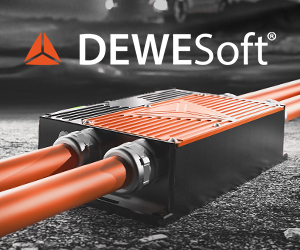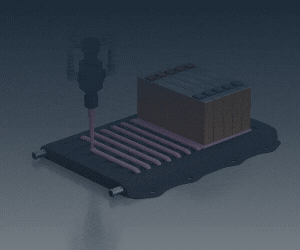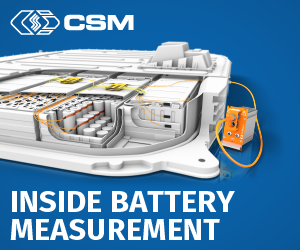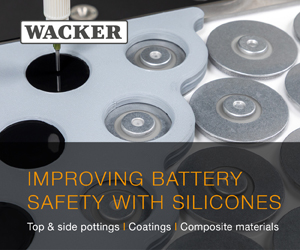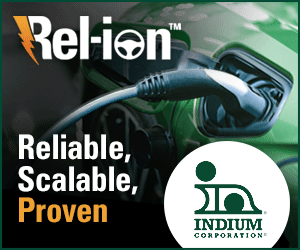Commercial cargo vehicle electrification

(Image: Hyundai)
In it for the long haul
Peter Donaldson investigates the future of electrification in road transport logistics
Electrification of road cargo transport is moving on from pilot projects to large-scale deployments. Its long-term success depends on the maturity
of powertrain technologies, the roll-out of infrastructure such as fast-charging networks, and on rethinking the entire vehicle and its place in the logistics system.
As they are developing in parallel with ubiquitous connectivity, electric trucks are becoming nodes in a dynamic information network. With constant monitoring of battery state of charge (SoC), energy consumption, location and driver behaviour, the truck becomes a source of operational data that can be used for predictive maintenance, route optimisation and fleet management. Routes and schedules can be adjusted in real time to account for traffic, new delivery orders and battery charge, integrating with digital logistics platforms.
Depot charging becomes a strategic operation managed to minimise electricity bills, while the location of high-power public chargers becomes a critical factor in route planning. When equipped with vehicle-to-grid technology, the truck can be regarded as a battery on wheels that can sell electricity back to the grid during peaks in demand and thus a fleet of trucks becomes a virtual powerplant. This shifts the emphasis of operating economics from a cost-per-mile basis to one in which total cost of ownership (TCO) and potential revenue per asset are more important.
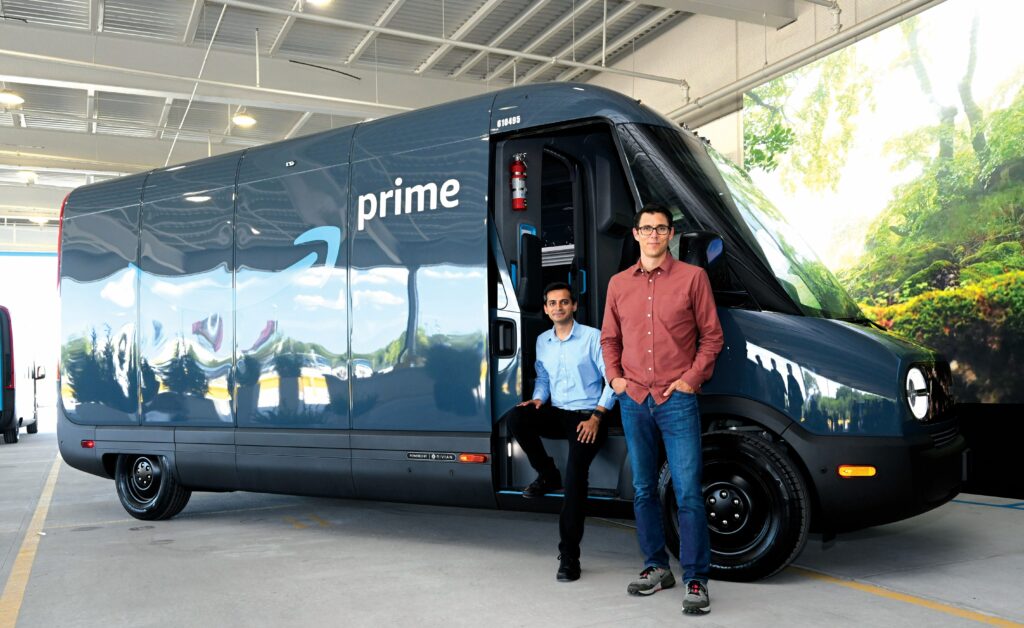
(Image: Rivian)
Political & economic drivers
The key drivers for electrification in all road haulage segments are both economic and political. Lower fuel and maintenance costs that contribute to lower TCO – despite higher upfront costs – are the primary economic driver. On the political front, increasingly stringent emissions targets, for example Euro7 in the EU and the California Advanced Clean Trucks (ACT) regulation, are forcing fleets to transition, while proliferating low- and zero-emission zones are restricting access to cities for ICE vehicles. These tightening rules are compounded by corporate environmental, social and governance policies through which major retailers and logistics firms seek to meet public net-zero commitments by decarbonising their fleets.
Not all sectors are maturing at the same rate and, inevitably, battery energy density is a major factor, with those vans and trucks that make shorter journeys and/or have the opportunity to charge more frequently leading the way into service. However, the industry is balancing energy density against other factors, and making a significant shift from nickel manganese cobalt oxide (NMC) to lithium iron phosphate (LFP) chemistries because of the latter’s longer lifespan, superior safety and the fact that LFP cells contain no cobalt. For the longer term, solid-state batteries promise gains in both vehicle range and charging speed. Equally important is battery pack architecture, with concepts such as cell-to-pack (CTP) and cell-to-chassis (CTC) improving pack-level energy density for any given cell chemistry, and even making the battery a structural part of the vehicle, further increasing overall energy density and saving space – crucial in the largest vehicles.
Purpose-built designs are coming to the fore. While conversions of ICE vehicles remain highly relevant, manufacturers are also designing platforms – particularly of the skateboard type – that house batteries, power electronics and e-axles in a flat platform, and allow a wide variety of body types to be fitted on top to optimise cargo space, driver comfort, ergonomics, weight and handling.
Beyond core powertrain and vehicle technology, charging infrastructure and operations management software are both essential to the success of the entire electrification project. For last-mile delivery and other vehicle fleets that return to base frequently, smart depot charging is crucial, with software optimising charging schedules to minimise or avoid demand charges from electricity providers – they levy such bills on fleets that stress the grid by concentrating charging at particular times – balance the grid and make the most of renewable energy sources.
For long-haul battery electric trucks, megawatt charging system (MCS) technology is the most critical development. This new standard for chargers capable of delivering up to
3.75 MW (for comparison, CCS goes up to about 350 kW) aims to support charging of a very large capacity truck battery from 10–20% to 80% in under 30 minutes.

(Image: Mercedes-Benz)
Last-mile & urban delivery
The most mature and rapidly scaling segment is that of last-mile and urban delivery vans, buoyed by predictable routes, relatively low daily mileage, and the widely recognised benefits of quiet operation and zero tailpipe emissions. The most prominent example is the deal between Amazon and Rivian to put 100,000 examples of the latter’s Electric Delivery Van (EDV) on the road globally by 2030, with more than 25,000 rolled out in the US by June 2025. Furthermore, other major logistics companies such as DHL, FedEx and UPS have been aggressively deploying electric vans such as Chevrolet’s BrightDrop, Ford’s E-Transit and Mercedes-Benz’s eSprinter, often coupled with on-site solar power and smart charging depots.
LFP is the dominant battery chemistry in this sector because its energy density is sufficient, its cost low enough, its resistance to thermal runaway high and its longevity exceptional. Furthermore, reliable, affordable Level 2 AC charging (7–22 kW) is readily available for overnight use in depots, while access to 50–150 kW fast chargers in urban areas supports multi-shift operations.
Fleets of these last-mile vehicles and urban vans in particular have potential to form a large and profitable distributed battery asset capable of stabilising the grid during the day when parked and fully charged. However, realising this potential will require deep understanding of demand placed on the grid, of vehicle operating and charging schedules and local traffic conditions, as well as standardised business models and utility regulations.
Vehicles in this segment are set to benefit more than others from more integrated, more efficient and cheaper inverters and onboard chargers based on silicon carbide transistors. These devices can operate at higher temperatures, frequencies and voltages with significantly lower energy losses during power conversion, enabling longer range or a smaller battery for the same duty cycle, together with faster charging. This efficiency also enables more energy recovery through regenerative braking in the stop–start driving mode to which these trucks are subjected. Finally, it allows for heavier/bulkier payloads within platform constraints because tolerance of high temperatures allows the use of smaller, lighter cooling systems.

(Image: ‘Dllu’ via Wikipedia)
Medium duty
Medium-duty vehicles such as box, refuse and utility trucks also lend themselves well to electrification because they too typically operate on fixed routes and can charge overnight at a depot. In terms of technological maturity, this sector is in a similar position to that of last-mile and urban delivery vans. However, medium-duty trucks need batteries with greater energy and power density, and meeting their payload/range targets often dictates the use of different combinations of cell chemistry and battery architecture. For example, the 18.6 tonne Volvo FL Electric has an NMC battery system to provide a competitive range (280 miles) within the constraints of a medium-duty chassis. Its battery pack is integrated into the truck’s ladder frame chassis, contributing to structural rigidity and allowing for a low centre of gravity. Purpose-designed reinforced ladder frames designed to integrate large battery packs and e-axles optimally have become the current industry standard for larger electric trucks.
Combining LFP chemistry with CTP or CTC architecture is an important and growing trend as manufacturers seek to benefit from the safety and longevity of LFP, while offsetting its lower cell-level energy density with more space- and mass-efficient battery architectures. Examples include BYD’s Class 6–8 vehicles, whose blade batteries are made up of long, thin LFP cells integrated into a CTP pack that forms part of the chassis frame; a combination that enables competitive payloads and ranges for urban and regional duties.
Likewise, numerous electric trucks from Chinese manufacturers for domestic and export markets are now built on platforms that integrate structural CTP-configured LFP packs from CATL, the world’s largest battery maker.
High-power regenerative braking is essential to the operating economics of refuse lorries in particular because their constant stop–start driving enables recovery of large amounts of energy while minimising wear on mechanical brakes. More sensitive battery chemistries and high levels of power delivered in operation received during fast charging make robust, responsive thermal management systems essential, and advanced liquid-cooling systems for both battery and drivetrain are common in this sector.
Smart management of depot charging is even more crucial for medium-duty trucks than for their smaller cousins because they can potentially run up massive demand charges from utility companies, which can be the largest part of the electricity cost.
In terms of emerging technologies, this sector stands to benefit from MCS for ‘opportunity’ charging. While they often charge overnight, a standardised MCS connector would allow for high-power top-ups during lunch breaks or between shifts, increasing utilisation. However, the hardware on the truck side is still in development.
Ultra-durable batteries able to withstand two or more charge cycles per day for 10 years or more without significant degradation would greatly reduce the whole-of-life cost of medium-duty electric trucks. These systems are still being proven in labs and in pilot fleets out on the road. The near-term goal is to achieve sufficient energy density for the application (for example, a 250 mile range) with maximum longevity and minimal degradation over thousands of cycles.
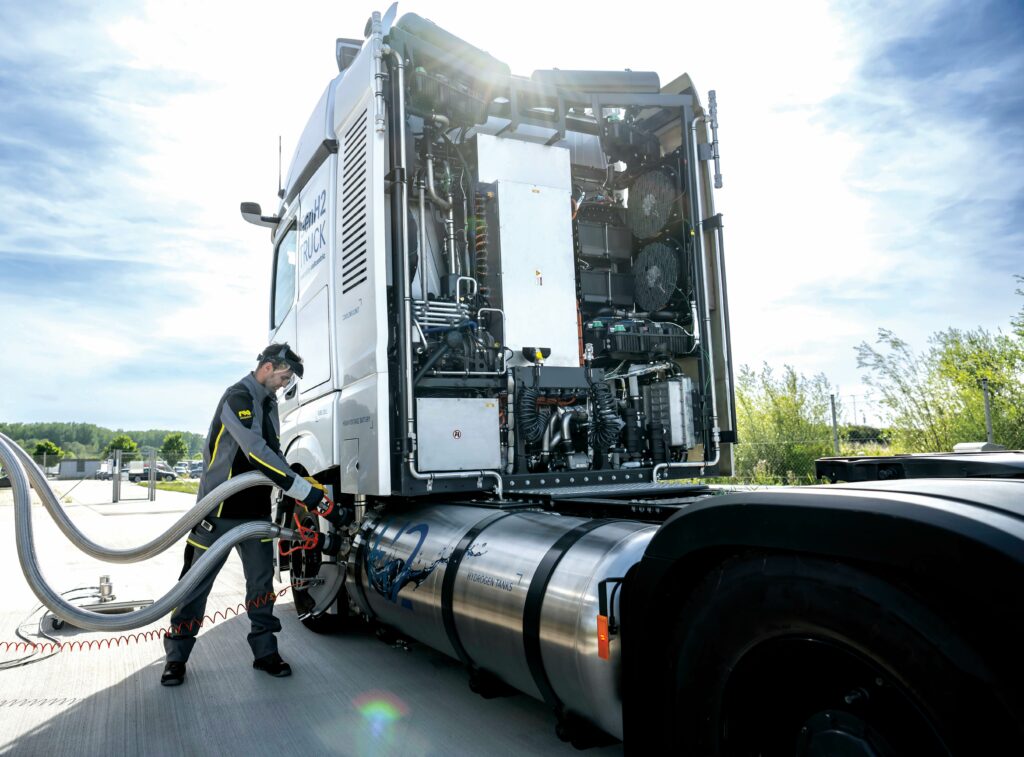
(Image: Mercedes-Benz)
Ultra-durable packs
LFP chemistry is the baseline for cathode durability, which can be paired with pure graphite anodes, for maximum durability, or with carefully engineered silicon-doped graphite anodes containing approximately 5–10% silicon, trading some longevity for a worthwhile increase in energy density in the order of 10–20%.
Higher silicon content in the anode can improve energy density further, but at the cost of longevity because silicon undergoes physical expansion and contraction of 300–400% when it absorbs and releases lithium ions during charging and discharging. This repeated swelling and shrinking pulverises the silicon particles, destroys the conductive network, and continuously breaks and reforms the solid electrolyte interphase layer.
Blending cathode chemistries is another approach to achieving the required balance of longevity and safety with energy and power density. This involves creating cells in which the cathode is formed using a homogenous physical mixture of LFP and NMC (or other) active materials. The goal is to create a synergistic effect that mitigates the weaknesses of each chemistry.
Pack-level blending, in which different modules within the pack have different chemistries, is also under investigation. This could enhance durability by assigning specific tasks to each chemistry based on its strengths, thereby optimising the lifespan of the battery system as a whole. However, this is more complex than it might initially appear because the battery management system (BMS) must manage two different voltage curves, ageing rates and thermal behaviours simultaneously, for example.
Arguably, the ultimate goal is a battery pack that can last for the whole useful life of the truck, which might be 1 million miles/15 years, with less than 20% capacity loss, and industry is aiming at this goal. CATL, for example, has announced a ‘million-mile battery’ based on proprietary technology.
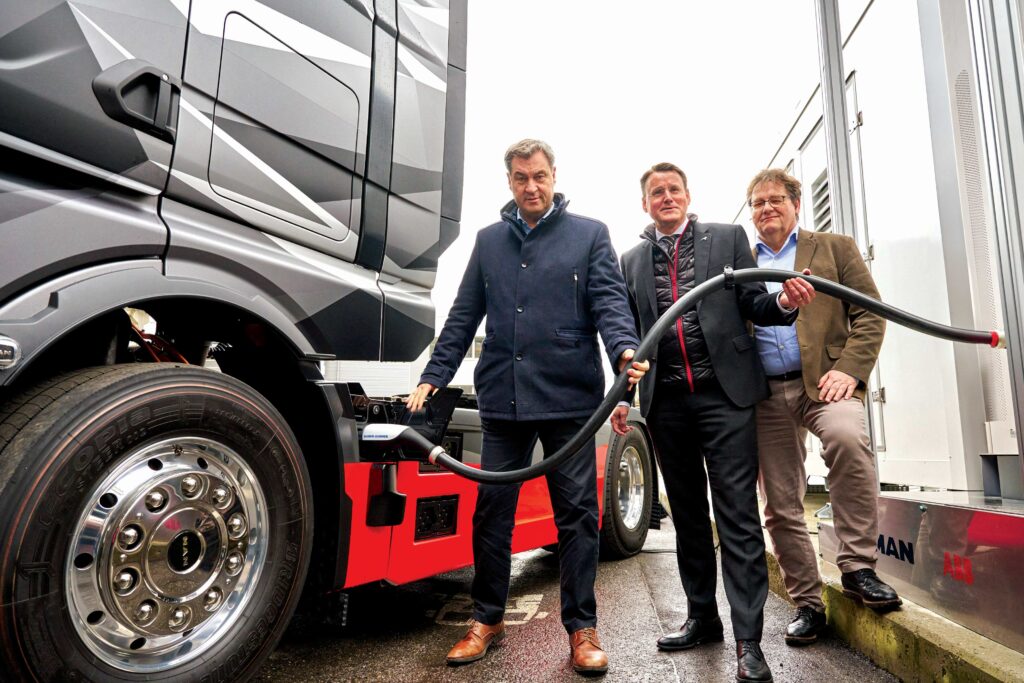
(Image: ABB)
Bigger & heavier
As trucks get larger and heavier, they need still larger-capacity batteries to meet the range requirements and extremely fast – megawatt-scale – charging. These Class 8 machines are divided into heavy-duty regional-haul vehicles with ranges around 250 miles and heavy-duty long-haul trucks capable of covering 500 miles or more.
Fielding of electric regional-haul trucks is in its early stages but accelerating fast with the development of MCS. Major logistics companies such as NFI Industries, J.B. Hunt and Maersk are running pilot introductions of vehicles from Freightliner eCascadia and Volvo VNR Electric on regional hauls of under 250 miles on which they can complete a full day’s work on a single charge. Perhaps the highest profile example of a heavy electric road-going truck is the fleet of Tesla Semis entering service with PepsiCo between its factories in Modesto and Sacramento, California.
The more mature of the enabling technologies here include ultra-high-energy-density battery packs, DC fast charging, aerodynamic design of tractor and trailer and predictive cruise control. It is critical that batteries maximise range with minimal weight penalty in such large road-going trucks, so at the time of writing they almost exclusively feature NMC chemistries. The DC fast chargers generally put out 150 to 350 kW, enabling top-up charging during loading/unloading or driver breaks to extend daily range or allow for multi-shift operation.
Aerodynamic design has huge influence on energy consumption at the highway speeds at which such big trucks cover most of their mileage, so active grille shutters, trailer side skirts and boat tails, for example, are essential to achieving the required range in a battery electric vehicle (BEV). These work in conjunction with predictive cruise control that uses satellite navigation and topographic map data to optimise speed and regenerative braking on hills.
The emerging technologies poised to make most difference in this sector include MCS – the single most critical factor – and weight/space saving CTC battery architecture.
Heavy-duty long-haul trucks represent the least mature segment of the market. MCS is a non-negotiable prerequisite for long-haul BEVs because without it, charging times for their massive traction batteries are prohibitive. This is more than just greater dependency on existing MCS technology, and the development of long-haul trucks will likely lead to a two-tier approach in the implementation of high-power charging.
The lower tier might be considered ‘MCS-light’, with power levels from 500 kW to 1 MW or so, enabling opportunity charging that adds enough energy during a standard break to extend daily range or add a second shift for heavy-duty regional-haul trucks. These machines have battery capacities of 500–750 kWh, which can achieve useful C-rates from chargers at these power levels, adding significant amounts of range in 30–45 minutes.
Charging for regional-haul heavy-duty trucks is semi-mature and in early deployment, with the underlying technology (high-power CCS) commercially available. Companies such as WattEV are already building and operating truck charging stations with 360 kW and 1.2 MW chargers in the US.
In contrast, long-haul heavy-duty ‘true MCS’ (1–3.75 MW) technology is still immature, and is going through pilot projects and standardisation efforts. Its primary goal is to enable direct replacement of diesel trucks on long-haul routes with the heaviest loads, and therefore must take a truck’s battery pack from, say, 20% to 80% SoC in 20–30 minutes – and that pack could have capacity of 600 kWh to 1 MWh. To minimise charging times, the industry is targeting sustained C-rates of 1.5C to over 3C, meaning continuous power levels of around 1–3 MW.
As well as new standards, this technology requires massive upgrades to the grid such as dedicated substations and/or on-site energy buffer storage to avoid astronomical demand charges. The MCS connector standard was issued in 2022, and the first prototype MCS chargers are being tested by manufacturers such as ABB, Siemens and ChargePoint in collaboration with truck OEMs including Daimler Truck, Volvo and Traton (the group that owns Scania, MAN, International and Volkswagen Truck & Bus). However, grid infrastructure for high-power MCS stations is the single biggest hurdle and is still in the planning stages.
Fuel cell potential
It is at this heavy end of the road cargo transport spectrum where the BEV truck could face the stiffest competition from hydrogen fuel cell vehicles (FCEVs), and it is not the only sector in which active FCEV trials are taking place. However, their viability is dependent on operational demands of specific road haulage segments, so they are unlikely to displace diesel everywhere, but could outcompete BEVs in challenging niches where the latter struggle.
Situations in which FCEVs have the best chance of doing this are characterised by four conditions. The first is high daily mileage, specifically routes longer than the maximum realistic range of a BEV (generally more than 300 mi/500 km). The second is heavy payloads because the weight of a massive battery would significantly eat into the payload capacity within a truck’s legal gross vehicle weight limit. The third is high power demand, particularly for operations in which auxiliary equipment such as refrigeration units, for example, draws significant amounts of power. The fourth and final condition is hard constraints on fuelling or charging, where multi-hour charging breaks are unacceptable or when depot charging cannot be installed because of grid limitations or lack of space.
The classic use case for an FCEV truck is long-distance point-to-point movement of freight between major hubs such as distribution centres, terminals and ports – a type of operation known as linehaul. This typically involves journeys of several hundred miles or more, primarily on major highways and running at constant speeds, often with full trailer loads to maximise efficiency.
A diesel truck can cover 600 to 1000 miles in a day with a 15 minute refuelling stop – performance that no BEV can yet match. A fuel cell truck that can refuel in 10–20 minutes to add 500 miles or more of range is the only zero-emission technology that can replicate a diesel vehicle’s duty cycle without major operational changes. BEVs are not competitive here without a ubiquitous MCS network and batteries so large that they would exact a significant payload penalty.
Heavy haul and transport of diverse outsize loads is another service in which FCEVs can shine. Carrying extremely large and/or heavy loads, such as wind turbine blades, construction machinery and transformers puts a premium on payload, and FCEV powertrains are significantly lighter than the equivalent BEV powertrain. BEVs face a severe payload penalty here, making them impractical for the heaviest loads.
FCEVs will also be able to compete with battery electric trucks in segments that are on the edge of BEV feasibility. One of these is multi-shift regional-haul operations. A BEV can often handle 200 miles in a shift with overnight depot charging, but if the operator wants to use the same truck for two or three shifts to maximise asset utilisation, the BEV may need to charge on an opportunity basis during the day.
The FCEV’s operational advantage is that it can be refuelled in minutes between shifts, just as a diesel vehicle can, allowing for continuous operation without long downtime.
However, if a BEV fleet operator can install sufficient capacity for overnight charging at the depot, and the daily mileage per truck is both predictable and within BEV range, their superior energy efficiency and lower ‘fuel’ cost often make BEVs the more economical choice.
Drayage – short-distance carriage of goods from a port to a nearby warehouse or distribution centre – is typically work that is ideal for BEV trucks because they return to a central depot to charge overnight. In some operations, however, port trucks are also used for longer ‘secondary’ hauls from the port to more distant distribution centres, while not all depots have the capacity to charge an entire fleet of BEVs simultaneously, which are cases where FCEVs represent an attractive alternative. This has been demonstrated by Kenworth T680 Class 8 trucks with Toyota fuel cells in Project Portal at the ports of Los Angeles and Long Beach, where the trucks haul cargo from the ports to distribution centres, exemplifying a duty cycle that requires high power and quick turnaround.
Hyundai’s XCIENT heavy-duty FCEV is at the heart of long-term trials around the world – in Switzerland, Germany, South Korea and the USA (California) – with more than 50 in Switzerland alone since 2020, which have collectively logged millions of kilometres. In Switzerland, they serve various logistics and retail companies on regional- and long-haul freight routes between cities such as Basel, Zurich and Geneva, refuelling at a network of hydrogen stations built for the project.
Daimler Truck is also testing Mercedes-Benz and Freightliner FCEV trucks in Germany and the USA, respectively. The first generation of Mercedes-Benz’s GenH2 trucks, with range of up to 620 miles, are in customer tests, with development of the second-generation vehicle in full swing, according to the company.
When the truck has to support significant hotel loads, such as refrigeration units that must run continuously for long periods, the energy draw is huge. Any battery capable of supporting such loads would be huge and expensive, but a fuel cell can efficiently generate the power on demand and potentially outperform a BEV in this and other extreme use cases. However, for standard refrigerated transport with nightly charging, BEVs are often sufficient. In use cases such as these, the balance of advantage between BEVs and FCEVs is often fine and can be tipped in favour of BEVs by the high price of FCEVs.
While core fuel cell technology and high-pressure hydrogen tanks have reached a high level of maturity, the refuelling infrastructure lags behind BEV recharging infrastructure. This and other real-world market readiness factors have led manufacturers, including Daimler and Volvo, to delay planned production ramp-ups to beyond 2029.
Back to the future
Another futuristic concept that is also an echo from the past is that of electrified road systems that charge vehicles on the move. The first trams and trolley buses drawing power from catenaries went into service more than a century ago, and the idea is being revisited for heavy trucks. Siemens Mobility, for example, has test tracks in Germany and California.
The most likely path to adoption is the electrification of key heavy-duty trucking routes such as I-5 in California, I-95 on the US East Coast or the European TEN-T core network. Another likely niche is in closed road systems in ports, airports and mines. However, the astronomical cost and the complexity of building and maintaining the infrastructure represent monumental barriers to general adoption.
The future of electric trucking, therefore, seems to be one of diversity in technologies, with BEVs, FCEVs and dynamically charged trucks dominating their own niches.
Click here to read the latest issue of E-Mobility Engineering.
ONLINE PARTNERS




















